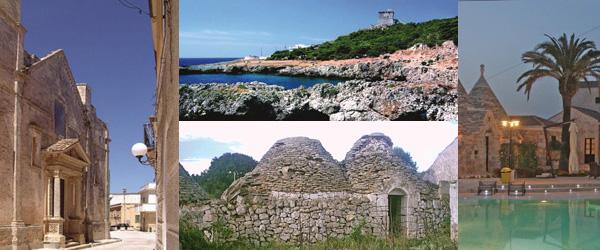Puglia (or Apulia) is famed for its dramatic and varied natural beauty, which includes a spectacular coastline, rolling plains and gentle uplands, producing grain and the nation’s largest volumes of wine and olive oil. The region has a very rich history and artistic and architectural heritage, which is today a point of attraction for visitors. Among the famous locations are the historic cities like Lecce, famous for its Baroque churches, the Byzantine city of Otranto and the small village of Alberobello with its circular buildings with conical roofs known as trulli and also masserie.
Bari is the capital of the region. The city lies roughly halfway along the Adriatic coast and consists of two parts, the old town (a maze of twisting lanes) lying on a small peninsula between the bays of the old and new ports and the modern city expanding inland as well as along the coast. Probably of Illyrian origins and prosperous under the Greeks, Bari was an important Roman municipium. In 1071, it fell into Norman hands and from that date shared the vicissitudes of the Kingdom of the Two Sicilies until it became part of Italy in 1860. Other important centre are: Taranto, Lecce, Foggia, Alberobello, Otranto and Ostuni.
STRONG INDUSTRIAL BASE
The economic strongpoint is agriculture and the region has welldefined areas of cultivation: grain in the Tavoliere area, olives in the Murge and Salento, vineyards and fruit trees in the area around Bari. Industry is concentrated in large urban areas, for example the machinery sector plays an important role in Foggia and Bari, petrochemicals in Brindisi and iron and steel in Taranto. A National Research Council technological centre has also been set up in Bari for the study of industrial and robotics technologies.
Puglia is the land of the fava (broad bean) and a wide variety of other vegetables are produced such as artichokes, chicory, rocket, cauliflower, aubergine and peppers. Lampasciuoli are a local curiosity; they are bitter onion-like bulbs that bring a unique tang to traditional dishes. Of great importance is the production of olive oil in the region, which accounts for nearly half of Italy’s total volume. Four types have been selected for DOP: Colline di Brindisi, Dauno, Terra di Bari and Terra di Otranto.
TO MAKE YOUR MOUTH WATER
The region’s supplies of durum wheat are more than enough to support local pasta-making (and much much more!). The most famous local kind are orecchiette (or strascinati) and cavatieddi, which are usually served with vegetables or tomato sauces. Also notable are the flat focaccia (or puddica) and variations of pizza from both wheat flour and potatoes. These include calzoni, calzuncieddi, panzerotti and sfogliate, where the dough is folded over a filling and fried or baked. Also very popular are biscuits, especially those doughnut-shaped frisedde and the curly taralli.
The regional cheese production includes the Canestrato Pugliese which is protected by DOP, named after the canestre or reed baskets in which it was formed and part of the production of the Caciocavallo Silano DOP take place in the region.
Puglia produces more wine than any other Italian region, usually making up around 17 percent of the national total and competes with Sicily for first place as grape producer. As with many other wines produced in the South of Italy, for a long time much of the wine made here was taken north where it was used to make Vermouth or to give structure to French and North Italian wines. In recent years, Pugliese vintners have changed their views and tastes and are pursuing wines that effectively balance sweetness, acid, alcohol content and density. The region has 25 DOC wines including the Salice Salentino, a powerful red produced in the Lecce province and made primarily with Negro Amaro.



